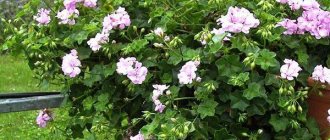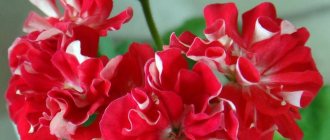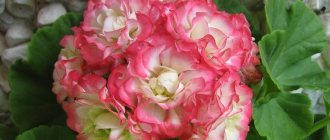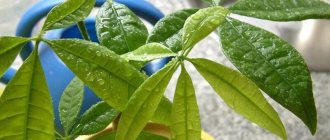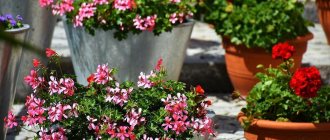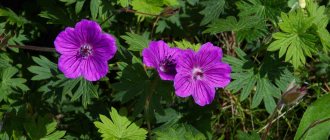This beautiful and unpretentious indoor, and if desired, garden plant with fragrant feathery or rounded leaves, with clusters of red or pink flowers, was loved by our great-grandmothers. We are, of course, talking about geranium, which is now more often called pelargonium. Previously, it was believed that this flower rarely got sick, and they didn’t bother with its treatment: after all, it’s very easy to grow a new bush from a cutting. Now pelargonists are actively discussing diseases and methods of treating their favorite plant at home, and everyone has a “green first aid kit.” What and why can indoor pelargonium be sick and how to help it?
Home conditions for pelargonium
Pelargonium (aka geranium), which is grown on windowsills, is a native of the South African savannas. And like all Africans, she loves the sun and warmth very much, but has a negative attitude towards soil that is too nutritious and too wet. Rain is rare in the savannah, and the land there is poor.
Pelargonium is a true African, it loves the sun, warmth and can tolerate a slight drought
In indoor floriculture, three types of pelargonium are known: zonal, royal (or royal) and ampelous. It is the zonal, or garden, geraniums that are planted in flower beds in the spring. They bloom for a very long time and reproduce without problems from cuttings. Royal pelargoniums are more whimsical. Their flowers are larger and more interesting than those of the zonal ones, but the flowering period is shorter and they are more difficult to reproduce. Ampelous geraniums are the most delicate and complex. But in general, pelargoniums are not very demanding and grateful flowers.
The strongest pelargoniums are zonal, royal and ampelous varieties, which are more delicate
The characteristics of flowering southerners must be taken into account when growing them at home. Place pelargonium window sills on the south, east or west side. Plant it in a cramped pot so that it blooms better, give it not very nutritious soil with a good drainage layer.
Pelargonium grows well on the sunny side, and a small pot stimulates flowering
Water rarely, but a lot, when it grows and blooms. But do not allow water to stagnate, remove excess water from the pan. In winter, only lightly moisten the soil; it should have time to dry out between waterings. There is no need to spray pelargonium; in nature it is not spoiled by high humidity. On the contrary, pubescent leaves can get sick if drops get on them. Be careful with fertilizing. Pelargonium can get sick from both lack of nutrition and excess. So keep your balance.
During flowering, pelergonium needs abundant watering and feeding, but during dormancy, excess moisture and nutrition can lead to disease.
Blooming geranium needs fresh air all year round; ventilate the room where it grows. This is a good prevention of fungal diseases. In the summer, give the flower walks: put it in the fresh air or even plant it in open ground. The geranium will literally bloom there. In the fall, bring the whole plant or its cuttings home again.
Organize cool wintering, optimally from +10 to +15 degrees. And in winter, just as in summer, pelargonium needs plenty of light. If there is a deficiency, the leaves will be small, and flowering will be sparse or buds will not form at all. If there is not enough sun, artificial lighting (phytolamps, fluorescent or LED) will help.
Indoor geranium responds well to pinching and pruning. Form a fluffy bush in spring and summer, trim pelargonium for rejuvenation. And be sure to remove faded flower stalks so that new ones appear.
Pelargonium needs good lighting all year round; without this it will not bloom, and may even get sick.
But don’t rush to transplant pelargonium from pot to pot. This plant is not prone to changing places. After relocation, she may turn yellow and become depressed so that resuscitation is required.
Correct and timely feeding and fertilizers
Geranium responds well to feeding. It is applied in spring and summer every 2 weeks. In autumn, it is enough to water with complex mineral fertilizer once a month. In winter, especially when kept in a cool apartment, watering is reduced and fertilizing is not done.
Pelargonium is an unpretentious indoor plant. Not only does it bloom beautifully, but it also cleanses the air of toxins. Geranium does not require special care. It needs to be watered as needed, periodically fed, and bushes formed. And then the florist will be able to admire the beautiful flowering of geraniums almost all year round.
Why do pelargoniums start to get sick more often?
Once upon a time, flowering geraniums were considered very healthy plants and resistant to all sorts of ailments. Probably the fact is that flower growers did not even try to understand why the leaves suddenly turned yellow or red, and the buds and flowers withered. They simply broke off a branch and grew a new healthy plant, and threw away the old one. Now pelargonium has become more expensive, both figuratively and literally. Flower lovers become attached to their pets and do not want to lose them. And varietal types of pelargonium are not so little worth throwing at them.
Pelargonium lovers try to cure their delicate pets if they are sick
At the same time, with the development of home floriculture, plants developed diseases that our grandmothers, who grew geraniums on the windowsill, did not even suspect. Oddly enough, progress is to blame. New varieties of pelargonium are very decorative; they bloom more brightly. And at the same time, they are more delicate and more easily infected with fungal or viral infections, and suffer more from care errors and metabolic diseases. Plant immunity has become much weaker. And fungi, viruses and pests are hardened, they mutate, adapting to modern drugs, and increase resistance. So it turns out that pelargonium lovers are forced to acquire special medicines and reference books to treat their flowers. But it is not all that bad. Pelargonium, which has been created in optimal conditions and is adequately cared for, will be healthy and certainly bloom.
Pelargonium will bloom with proper care
Video: all about the problems of caring for geraniums
Why ampelous geranium does not bloom
If a gardener wants to get abundant flowering, then for this he needs to follow some rules for growing geraniums.
Conditions under which the plant does not bloom:
- insufficient lighting;
- insufficient feeding;
- the pot is not completely filled with the root system;
- temperature changes and drafts.
For your information! But the most important reason why geraniums do not bloom is excessive watering. Diseases of ivy-leaved pelargonium can also directly affect its flowering.
Diseases and pests of pelargonium
Diseases of pelargonium can be divided into two large groups: non-infectious and infectious. Non-infectious diseases cause violations of the rules of care and metabolic processes of the plant. These are hypothermia, swelling, deficiency or excess of microelements, a reaction to chemicals. Infectious diseases are the result of infection by a fungus, bacteria or virus; these are various rots, spots, rust, powdery mildew, and blackleg. Such diseases are dangerous because they are easily transmitted from flower to flower. Therefore, when an infection is detected, it is necessary to urgently take quarantine measures to prevent infection and epidemics.
A plant with an infectious disease must be isolated, otherwise the entire collection will become infected
Pests are not too fond of pelargonium. For example, a punishment for flower growers - spider mites or scale insects rarely attack geraniums. Perhaps the specific aroma of the essential oil contained in the foliage of most plant species repels insects. But whiteflies, aphids, mealybugs and rootbugs are not bothered by this feature. And in the summer, when kept outside, geraniums are attacked by caterpillars.
How to get rid of the problem - detailed instructions
First of all, the flower is quarantined so that it does not infect other crops in the apartment. A careful examination of the roots, soil, leaves, and stems will help you make the correct diagnosis.
Rust
If your geranium is affected by rust, then you should take the following measures::
- move the flowerpot with the plant to a dry and cool place;
- reduce watering to a minimum;
- diseased leaves should be cut off;
- treat geranium with Topaz - a special preparation.
It is worth understanding that a flower can be cured only at the initial stage of infection.
Fungus
If geranium is infected with Botrytis fungus, you will have to act as follows:
- cut off all affected areas;
- treat with systemic fungicides;
- reduce watering;
- loosen the soil.
Ring spot
If a flower is affected by this disease, it cannot be cured.
As soon as you notice the first symptoms of ring spot, destroy the plant and the soil in which it was located.
Spider mite
To get rid of spider mites, you need to put in a lot of effort. It is worth noting that this parasite is a microscopic animal, so it is useless to use insecticides . The algorithm of actions is as follows:
- Give the plant a warm shower with laundry soap - this process destroys 50% of the entire parasite population.
- Wash everything that was near the plant, disinfect the windowsill and window, wash the curtains.
- Water the plant and pack it in a plastic bag for 3 days. The tick does not tolerate high humidity.
All these actions will help only at the initial stage of the disease; if the web has entangled the entire plant, it will have to be destroyed.
Alternaria blight
Often a plant becomes infected with this disease through the soil ; it can be cured as follows:
- change the soil in the flowerpot;
- treat geranium with Ridomil Gold or Skor;
- ventilate the room daily;
- loosen the soil;
- use the optimal humidification regime.
Insects can be removed in the following ways:
- Wash the flower with soapy water.
- Wipe with a cotton swab soaked in an alcohol solution.
- Treat with medications.
Phytocontrol measures
It is easier to prevent a disease than to cure it; this principle of prevention also applies to plants. And her main rule is hygiene. A plant free from diseases and parasites and clean soil will be the key to healthy pelargonium. A flower can pick up an infection or parasite anywhere: in a nursery, in a store, in the soil. To protect your green pets, introduce home phytosanitary control. These measures will ensure the safety of the plants.
- Make sure the new plant is not infected with disease or parasites. Before bringing it home, inspect the stems and leaves, and, if possible, the roots. If there are spots, dots, other damage or symptoms of disease, you should be wary. Inspect geraniums for insect pests. An innocent white speck may turn out to be a mealybug. If the damage is severe, it is better to abandon the plant; it can infect others. And such an acquisition will bring more trouble than pleasure.
- The new plant, at first glance, is completely healthy. Don’t be complacent about this and don’t rush to add him to the other green pets. Health problems may appear later. Fungal and viral diseases have an incubation period during which symptoms do not appear. And pests whose adults have been destroyed can leave behind larvae. Keep the new flower in isolation for at least two weeks, and preferably at least a month. Only after quarantine introduce him to the rest of your windowsill neighbors.
- Be careful when replanting pelargoniums. She doesn't like this procedure anyway. Additionally, most bacteria, fungi and parasites are spread through soil. And store-bought soil is no exception. It may contain not only useful components, but also fungal spores. Before planting, be sure to disinfect the substrate and drainage by heating, and pour boiling water over the pot. You can also water the new soil with a solution of some fungicide.
An infection or pest can enter the house from the greenhouse, so keep new plants in quarantine
Video: inspection of new plants and preventive treatment
Control of parasites
Inadequate care makes pelargonium weak, and then it is “attacked” by various kinds of insects. Geranium pests and measures to combat them:
- Root mealybug . Waterlogged soil is a comfortable environment for the parasite, and geranium roots are its favorite food. After checking the root system, you need to cut off the areas with scale insects with a clean knife, and keep the healthy roots in a container with hot water for 2-3 minutes, then dry them and sprinkle them with charcoal powder. The bush is transplanted into another pot with sterile soil. The first pot must be doused with boiling water and treated with a sterilizing agent, just like a garden knife.
- Mealybug. Sometimes a novice gardener cannot understand who is eating the geranium leaves on the window. If white sticky lumps appear on the leaf blades and other parts, then this is a mealybug. The diseased flower should be isolated and the parasite removed manually, and then sprayed with a soap solution and alcohol. Advanced stages of damage by parasites require treatment with insecticides: Actellik, Aktara or Fufanon.
- Spider mite. Spider mites on geraniums gnaw through the skin and suck juices from leaves, stems, buds and petals. It spreads gray mold and viruses. All damaged parts are removed from the plant, removed from the pot and the stems and leaves are washed thoroughly under a warm shower with a soft sponge. After this, treat with a thick soap solution and do not wash it off for half a month, covering the bush with a bag. Then rinse thoroughly with warm water. Pots, trays, and flower stands must be treated with boiling water. Ticks can also be on window sills, frames, and in window cracks, so they should be washed with a solution of water and laundry soap, then treated with alcohol, and the curtains should be washed. Ticks do not like yarrow and garlic tinctures. To prepare an infusion of yarrow, grind 400 g of the dry plant and pour 1000 ml of boiling water. After 10 minutes, dilute with another 5 liters of water. Leave in a dark place for 2-3 days and treat the bush 3 times with a break of several days. For garlic tincture, you will need 180 g of product per 1000 ml of warm water, let the composition brew in a dark place for 7-8 days, then treat the bush by mixing 1 liter of water with 10 ml of tincture. Naphthalene, dichlorvos or turpentine are often used: naphthalene tablets or cotton wool soaked in a toxic agent are placed next to the pot, in a tray, then the bush is sealed with a plastic bag for 2 days, securing the bag with rubber bands or clothespins. The parasite will die during this time.
- aphids on geraniums at home: shoots and leaves will curl and become deformed; they need to be cut or removed manually.
- Whitefly. It develops vigorous vital activity on the reverse side of the leaves. It is removed with the drug Actra.
- Caterpillar. It lays larvae and makes many holes in the leaves. The drugs Senpai or Lipidocide will help rid the flower of parasites.
Symptoms and diagnoses (table)
| Manifestation of the problem | Care error | Disease | Pest |
| Pelargonium leaves turn yellow and fall off. | Too warm air, excessive watering or draft. | Root rot in the initial stage. Excess nitrogen in the soil. | If white fluffy lumps are visible in the sinuses, it is a mealybug. |
| The lower leaves turn yellow and the edges dry out. | Old leaves die over time, this is a natural phenomenon. | Nutritional deficiency. | |
| There are wet areas on the stems, the leaves wither. | Stem rot. | ||
| Pelargonium does not form buds and turns yellow. | Very high temperature, high humidity. | Not enough nutrients. | |
| The plant has stopped growing, the leaves are limp even after watering. | The pot became too cramped. | Lack of nitrogen, low soil acidity. | Inspect the undersides of the leaves. It could be a whitefly or mealybug infestation. |
| There are brown-red spots on the foliage, the trunk also turns red. | Hypothermia or too much direct sun | ||
| Black dots on leaves. | Unbalanced watering, pelargonium is either dried or watered. | ||
| The leaves turn yellow in the center, the edges remain green. | Magnesium chlorosis. | ||
| The edges of the leaves turn white, but do not dry out, and may be limp. | Nitrogen deficiency. | ||
| The stem darkens and rots from below. The leaves are withering. | Blackleg. | ||
| Leaves wither and droop like umbrellas | Soil drying out. | Fungal infection. | |
| There are swollen watery tubercles on the leaf blade. | Overwatering of the soil is sometimes combined with periods of dryness. | Edema (edema). | |
| Brown-gray spots on the leaves and stems of the plant, especially in the lower part. | Gray rot. | ||
| Pelargonium does not grow, turns yellow entirely, and fades. | Root rot in advanced form. | Root mealybug | |
| The stem stretches out unsightly. | Lack of light with short days. | Etiolation. | |
| The roots and lower part are covered with spots pressed inward. The spotting quickly spreads upward. The plant withers if left untreated and dies. | Stem and root late blight. | ||
| On the upper side of the leaf blade there are light green blurry spots with brown dots in the center. They quickly increase in size and merge. | Rust. | ||
| Light spots with a ring pattern on the leaves. Later they become deformed. The plant does not develop and does not bloom. | Ring spot. | ||
| There is a whitish coating on the leaves. | Powdery mildew. | ||
| Yellowing of leaves along the veins. | Tobacco or tomato viruses. | ||
| The leaves have holes of different sizes. | Caterpillar attack. | ||
| Young shoots, leaves, buds curl and die. | Aphid infestation. | ||
| A net forms on the leaves, with a green pattern along the veins and yellow spots between them. | Manganese deficiency. | ||
| The leaves lose color and turn pale. | Chlorosis, iron deficiency. | ||
| The leaves become very dry at the edges and curl. | Bacterial burn. | ||
| The edges of the leaves turn brown and dry out. | Reaction to a low-quality fungicide or its excess. | Excess phosphorus. | |
| The leaves are green, but curled up. | Reaction to watering with herbicide. | ||
| The leaves die, there are greenish larvae on the underside, and flying insects around. | Whitefly infestation. |
Medicines for geranium
Geranium not only pleases with the beauty of its flowers and leaves, but also brings benefits. It is used as part of drugs that destroy bacteria, to treat runny noses and purulent wounds; the smell of the plant calms the nervous system.
To save your favorite flower from problems, the following medications are used for it:
- Aspirin - in case of detection of insects. The leaves are sprayed with a solution: one tablet is dissolved in 8 liters of water. Repeat the procedure after 20-25 days.
- Marathon - to kill insects. Water the soil with the solution a few days after planting the plant.
- Messenger. The product increases the immunity of geranium.
- Monterey. The product is sprayed to kill caterpillars on leaves and trunks.
Geranium diseases, treatment and prevention
Pelargoniums most often get sick due to waterlogging of the soil. It is the flooding of the plant that gives impetus to the development of various types of rot and spotting. The disease progresses especially quickly if the room is stale, stale air, too cold or, conversely, too hot. Pelargonium gets sick from a deficiency of microelements, but also from overfeeding. These problems weaken the immune system. As a result, the plant becomes more easily infected with fungal or viral infections.
Problems caused by metabolic disorders and care errors
Diseases related to care and metabolism are not contagious. Plants with etiolation, chlorosis, deficiency or excess of nutrients are not sent to quarantine. But these ailments cannot be left without treatment, because sooner or later they will lead to more serious problems.
This pelargonium is suffering from care errors; the leaves have turned red either from hypothermia or from too much direct sun.
Etiolation is a disease of light deficiency. If pelargonium does not have enough light, it stretches unsightly, the leaves become smaller and lighter. Such a plant will not bloom. It is not difficult to cure: place the geranium on the sunny side, and in winter add artificial lighting. Just be careful, get used to bright light gradually so that there are no burns. In addition, for the harmonious formation of a flower, it is useful to turn it towards the light with different sides.
With a lack of light, the leaves become smaller and lighter, the stems elongate
Edema, or edema, mainly affects ivy-leaved pelargoniums, less often other species . The cause of the disease is non-drying soil combined with cold and humid air. The roots absorb water, but the leaves do not have time to evaporate it.
Too much watering and humid air lead to swelling of the leaves.
The tissue ruptures and watery pads form on the underside. Affected leaves die or lose their decorative properties. The pads enlarge and become coarser, acquiring a brownish color. Therapeutic measures include drying the soil, adjusting watering, and reducing air humidity. Prevention - good drainage and fresh air.
Magnesium deficiency causes leaves to turn yellow in the center.
Chlorosis is a disruption of the process of photosynthesis. Symptoms of the disease are changes in leaf color and slower growth. Usually, when talking about chlorosis, they mean iron deficiency. But in pelargoniums, the lack of other chemical elements also affects health and appearance. For example, a deficiency of magnesium causes yellowing of the center of the leaves, a lack of manganese causes a green mesh to appear along the veins with yellowness inside, the edges of the foliage turn white from a lack of nitrogen.
White edges of leaves are a lack of nitrogen
In all cases, there is only one solution - to choose a mineral complex containing the necessary components. For example, iron chelate (Antichlorosin) for deficiency of this element. Or a fertilizer balanced in composition.
Treatment of chlorosis is the selection of a nutritional complex with deficient elements or transplantation into fresh soil
Pelargonists note that the preparations Uniflor-Rost, Uniflor-micro, plant regenerator Pokon Green Power, Agricola Aqua for yellowing of leaves have proven themselves well.
But no less than a deficiency of nutrients, their excess is harmful for pelargonium. Too much nitrogen in the soil will cause the leaves to turn yellow; too much phosphorus will cause the edges to become brown and dry. Therefore, it is better to slightly underfeed the geranium.
Phosphorus is beneficial for plant flowering, but its excess is harmful to leaf health
Metabolic problems can also be solved by transplanting pelargonium. The right substrate should have everything you need for growth and health.
Geraniums find it difficult to take root in a new place. Immediately after transplantation, they need gentle care. Pelargonium is placed in a warm place. Shade from direct sun. Water moderately; unestablished roots easily rot. No spraying is necessary. You can add stimulants to irrigation water: epin or zircon.
Too concentrated a fungicide solution can harm pelargonium
Pelargonium can get sick after using herbicides or fungicides. The former are used to control weeds in open ground, the latter - to treat rot. In this case, transplantation or gentle transshipment will help. may have to get rid of the affected foliage, but it will grow back. The main thing is the condition of the root. If it is healthy, the plant can be treated.
Pelargonium treated with herbicide may lose all leaves
Infectious diseases
A fertile environment for the development of pathogens of infectious diseases is waterlogged and unsterilized soil. Various fungi, bacteria and viruses multiply there quickly. Pelargonium that has contracted an infection must be isolated. If a green patient is left among healthy people, everyone can become infected. Some infections are so fleeting and dangerous that immediate destruction of the diseased plant is required.
If you do not pay attention to pelargonium disease, it may die from infection.
Prevention of infectious diseases:
- attentive, without excess, watering;
- dry air, especially in a cool room;
- mandatory soil sterilization;
- pest control;
- quarantine for new plants.
Scale insects on houseplants: an excursion into etiology
The scale insect is a representative of a large family of hemiptera. A sucking insect from the order of scale insects feeds on plant sap. The damage is caused by female scale insects and larvae.
Important! The pest can reproduce almost all year round: females are able to regenerate independently and continuously, forming 5-6 generations of larvae per year.
What does a scale insect look like? The insect attached to the leaves of the plant resembles a drop of wax, a shiny tubercle of a round-oval shape.
This is the so-called a waxy shield that protects the body of the pest from contact with an unfriendly environment and helps attach to the plant tissue. Note: description and photo of the scale insect.
- The insect is 1.5-2 mm long and up to 5-7 mm, the color is light brown, brown-violet, amber.
- In adulthood, females are characterized by neoteny - these creatures are deprived of paws, eyes, antennae, etc.: they are only able to reproduce and protect themselves from attack with a waxy shield-like shell.
- Males are luckier: they have wings, they move quite quickly, but they live for 3-4 days, and their mouthparts are reduced - males do not feed. Their body is segmented, often white, with villi, sometimes red-brown, and has three pairs of legs, eyes, and antennae.
- Larvae of the first instar (also known as strays) are up to 0.2 mm in size, flattened-oval, white or gray, the larvae of the second instar are up to 0.5 mm in size, darker, lacking all organs except the oral ones.
- Eggs up to 0.3 mm, light.
The malware reproduces quickly: the female lays about 3,000 eggs at a time!
There are differences between scale insects and false scale insects.
Scale insects (Diaspididae) are insects of the order Cokicidae. The body is round, in females it is covered with a shield on top. The oral apparatus is sucking.
The false scale insect (Coccidae or Lecaniidae) is a similar pest of the suborder Coccidae, an insect of a slightly smaller size (3–7 mm) that does not have a shield - more precisely, it grows together with the body.
If, when separated from the leaf, the shield becomes detached, but the insect remains on the leaf, we have a scale insect.
After oviposition, the adult female pseudoscale insect stops moving and attaches itself to plant tissues, protecting the larvae and oviposition with her body.
The males of the two species are very mobile, but do not live long, up to 4 days.
The first instar larvae are mobile, later they join the plant and stop moving.
Signs of damage: how to determine that scale insects have settled on plants?
- Withering young shoots, lack of formation of new ones.
- Yellowing of leaves, inhibition of growth, lack of flowering, dropping of color and leaves.
- The rounded scales or “blobs” on the leaves are adults. At the injection site there are yellow spots that grow as the insect consumes the juice, after which the leaf curls and turns yellow.
- Plaque on the leaves: so-called. span, honeydew secreted by insects.
- Dark plaque on damaged leaves: this is a sooty fungus that parasitizes the affected tissues of the flower.
Basically, scale insects on plants settle along the central vein of leaves on their back (bottom) side.
Most often, the insect damages thick, succulent leaves, and less often, petioles and shoots.
Reproduction
Ivy geranium is propagated by two methods: seeds and cuttings.
Seeds
This method allows you to obtain a lot of planting material, although you can also purchase it in a specialized store. But just sowing seeds is a complex process that requires compliance with the following recommendations :
- It is necessary to sow planting material from November to April. In winter, sprouts require additional lighting.
- For the development of a strong root system, the soil must be loose and light.
- Seeds should be sown in peat pots or tablets. Seal them no deeper than 5 mm.
- Cover the container with the crops with plastic wrap.
- It is better to use a spray bottle to water the seedlings.
- 30 days after the appearance of the first shoots, you can pick and plant the plants in separate containers. From this moment on, it is necessary to fertilize the geranium.
We invite you to watch a video about planting geranium ivy seeds:
Cuttings
This method of reproduction is used most often. Let's look at how to prepare planting material and root cuttings into the ground. Procedure :
- Using a sharp knife, cut cuttings from the tops of vertical shoots. Do this in August or March.
- Choose shoots that are at least 7 cm long. They should also have 2 leaves.
- After cutting, dry the shoots for 15 hours and treat with activated carbon powder.
- Root the planting material into loose soil. You cannot deepen the cutting more than 4 cm.
- Cover the container with non-woven material that allows air to pass through well and does not form condensation.
We invite you to watch a video about cuttings of ivy-shaped geranium:
Read more about the propagation of ivy-leaved ampelous geraniums and subsequent care here.
Planting and transplanting
Ivy geraniums need to be replanted every 2 years in the spring. Each time you replant, you need to change the pot so that it is slightly larger than the previous one. In this case, the composition of the soil should remain the same.
Procedure:
- Place drainage at the bottom of the pot. These could be broken bricks, pieces of foam.
- Remove the geranium along with the earthen lump from the old container. To facilitate this procedure, water the plant first, and when the water is absorbed, turn the pot over, holding the lump and plant with one hand, and the pot with the other.
- After removing the plant, you need to carefully examine the root system to ensure there is no damage or decay. Remove all suspicious parts with scissors so as not to touch healthy roots.
- Place the plant in a new pot, and fill the void between the walls and roots with a new and slightly moistened substrate.
- The soil near the root must be compacted well so that there are no voids.
- Water the plant with water at room temperature and place in the shade for 7 days.
- After a week, move the pot to a permanent place.

